Page 2 of 3
Re: Issaquah 14
Posted: Wed Apr 08, 2009 9:08 pm
by Chinook
Got back to work on the Canoe after a 2 week break and did a weight in with the trusty bathroom scales the outer gunwales are on the inside fillets and 3 fill coats of epoxy on the outside (sanded between coats), weight 30-31 lbs.
After glassing the interior the weight is now around 35lbs, looks like we should come in at less than half the weight of the old canoe

I still haven't decided how to do the inner gunwale, it will use some kind of spacers but I haven't figured out what combination of spacer size, spacing and thickness for the inner gunwale strip will produce the required strength, if I understand the plans correctly they call for a total height and thickness of 1 inch.
The outwale is 1x 7/16" , today I made up a couple of strips for the inside the same size, if I'm doing the maths right a 3/8" thick spacer 2" long and then a 4" gap before the next spacer should weight the same and be stronger than the the solid gunwale, does that sound about right?
I can still run the the inwales through the planer again to lighten them up, they are nice close grained quarter sawed spruce
Re: Issaquah 14
Posted: Wed Apr 08, 2009 9:23 pm
by jem
It won't be as strong as a solid gunwale but it should be plenty strong enough.
Re: Issaquah 14
Posted: Wed Apr 15, 2009 8:01 pm
by Chinook
Used every clamp I had (all 34) to do one side
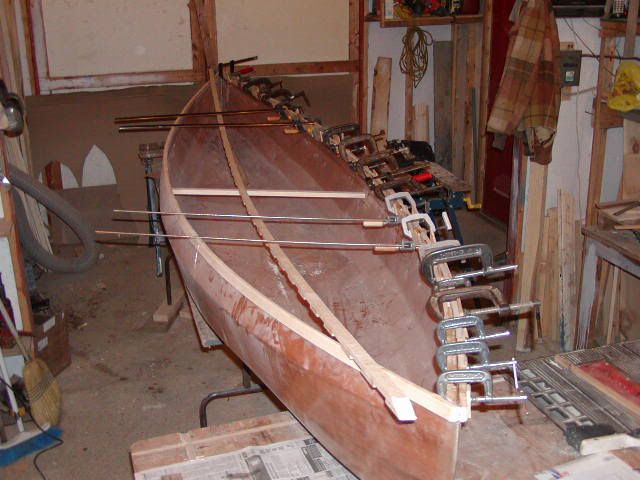
I got the inner gunwale on using 1/4" spacers 3" long followed by a 3" gap, the difference in stiffness of the hull was amazing over just the outer gunwale, already stiffer than my fiberglass canoe.
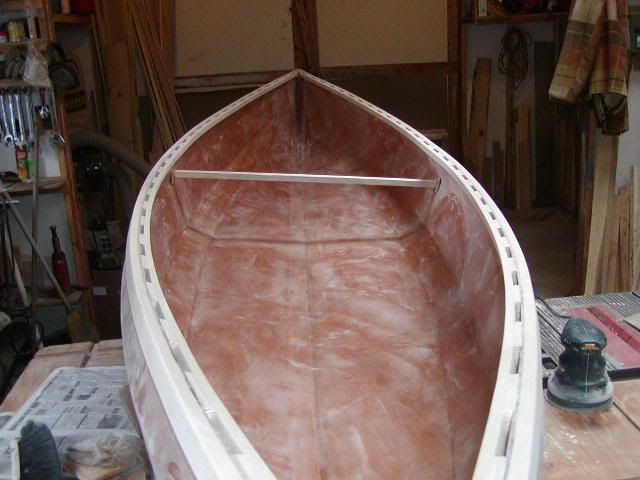
Scratching my head

watching out for splitters and wondering how I'm going to attach the mini decks/breasthooks I would like to incorporate them into buoyancy tanks. The problem I see is that due to the tumblehome the top of the gunwale slops in at up to 15 degrees not leaving much of a gluing area for the deck the further away I get from the bow or stern, i would like to get back about 16"
I'm wondering how others are doing this so far I've thought of 3 methods
Use a router ...... too dangerous
Use lots of wood flour and fill the gap.......... potentially messy
Make a wood spline, glue in place and plane level................ a pain but should work.
Any easy way?
I should have thought of this before fitting the inner gunwale.
Next time!
Re: Issaquah 14
Posted: Wed Apr 15, 2009 9:00 pm
by jem
you could fit the deck top to size, trace on the hull with a pencil, then glue on some small cleats to glue the deck to.
Re: Issaquah 14
Posted: Thu Apr 16, 2009 10:45 pm
by Kayak Jack
Chinook,
You will come to love those ventilated gunnels. You have formed a box beam there, and it is a robust structure. Also, you can roll the boat on its side to get the last bit of water out. Also, very handy for lashing in gear. I glued a couple of triangles to the floor of my canoe, They are drilled through, and serve as cargo tie down points.
Only one form more beautiful than a graceful canoe, and she walks.
Re: Issaquah 14
Posted: Fri Apr 17, 2009 6:23 am
by Chinook
I love the look of them and they should be very useful but the increase in rigidity was truly amazing, I gave them a sealing coat of epoxy yesterday and the love lost a bit of its luster but well worth it, sanding should be fun

Had another look at the decks and cut the ply out and played around with some splines or cleats like Matt suggested, I think, the job didn't look as bad as I first feared, will start on it today but it should take a few days as I have a few other little jobs to do in the pointy ends before the decks can go on.
Re: Issaquah 14
Posted: Sat Apr 18, 2009 7:16 pm
by Chinook
I have a defect in my DNA that leads to a compulsion to laminate something whenever I build a boat
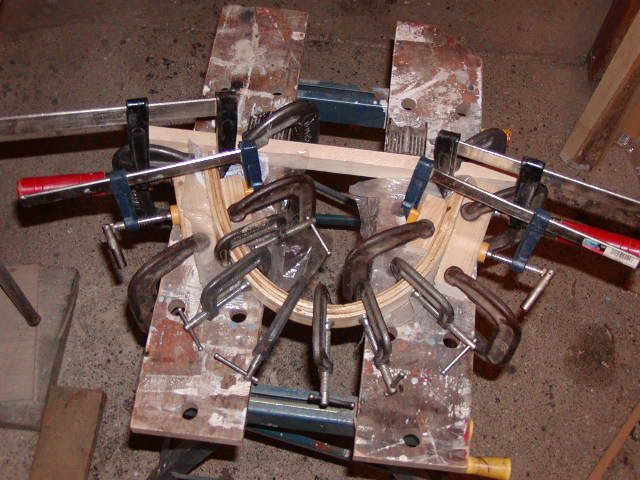
It was a little tricky as the breast hook turns in 2 directions due to the tumblehome but a few beveled blocks took care of it
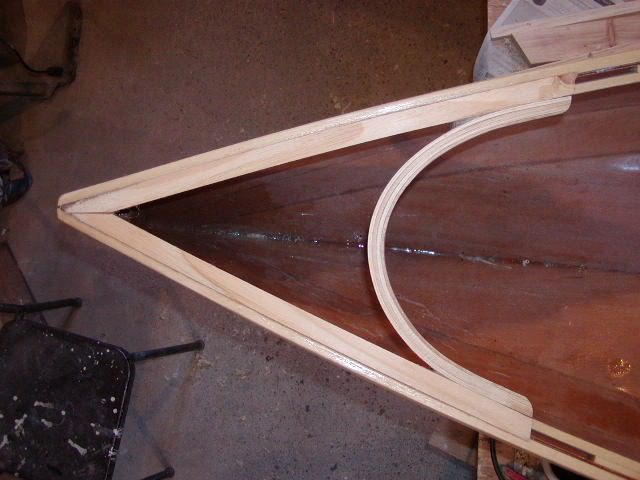
You won't be able to see it once the deck is on but at least its out of my system.
I glued a coupled of beveled strips onto the top of the inner gunwale and planed them level to take the deck, spent more time thinking about it than doing it in the end.
The latest weight in with the gunwales is approx 36lbs, still have the seats, yoke and buoyancy compartments to go so it looks like the fully rigged weight will be pushing 42lbs
Re: Issaquah 14
Posted: Mon Apr 27, 2009 9:42 pm
by Chinook
Finished stern deck and buoyancy compartment.
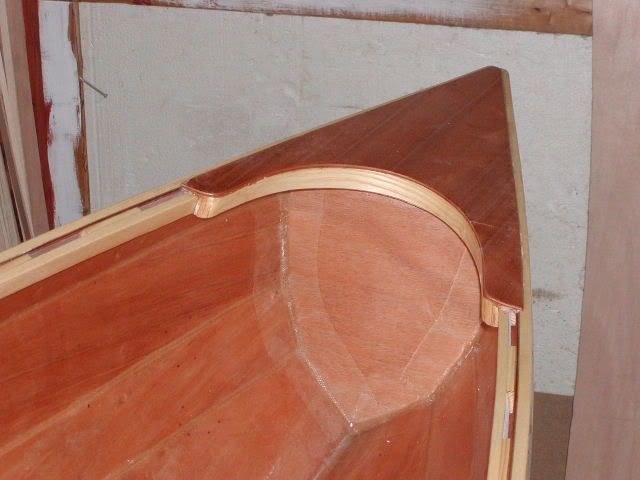
Getting there, seats next.
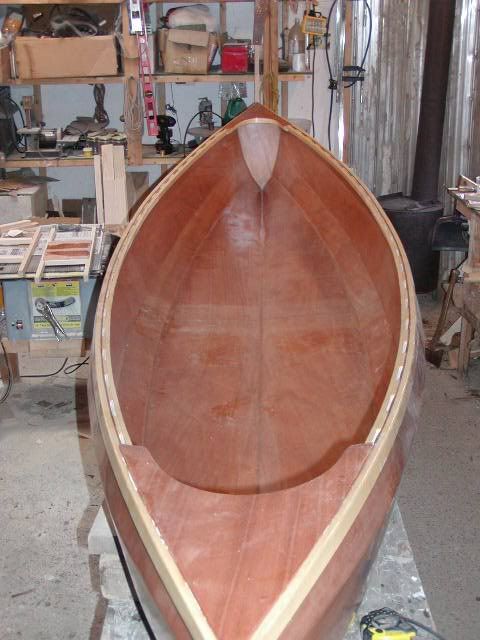
I made some seats up out of Styrofoam blocks and took the boat down to the lake at the back of the house to find out the best place for the seats, besides I needed an excuse to get her wet.
I mounted the seats 9.5" above the bottom of the boat, I wanted them as low as possible and this height is comfortable in my old canoe.
After playing around a bit the middle of the bow seat ended up 55" back from the bow and the stern seat 33" from the stern with 2 people weighting 112lbs in the bow and 135lbs in the stern. Adding a 50lb dog in the middle made little difference to trim.
We then went for a short paddle and were very pleased with the performance,

I would describe the canoe as alive and responsive but not excessively lively, the stability was good, didn't push it though, as the water is only a few degrees above zero.
I love the way this boat turns (about one boat length) compared to my old 90lb canoe that featured a full keel, this boat has enough maneuverability that I might feel brave or stupid enough to take it down some of our more rocky rivers.
She weighs in now at around 40lbs, I've been keeping track of the weight for future reference to see where weight could be saved. So far I think I could save a few pounds by doing away with the breasthook, deck and buoyancy compartment and replacing them with a simple deck (like Matt suggested) and attaching Styrofoam blocks under the seats.
The gunwale could probably have been lighter, I lucked out and got some really good strong wood and could have taken better advantage of it.
The seats and yoke weight just over a pound each so it looks like the final weight will be in the 42-44lb range.
Re: Issaquah 14
Posted: Tue Apr 28, 2009 6:37 am
by Kayak Jack
Chinook,
On weight savings, I agree with your statements of no buoyancy chambers, and lighter gunnels. My gunnels should have been thinner. For spacers, I cut off triangles (45X45X90) from a 1/2" thick strip that was 1" wide. Half that thickness would have been better. Then, I didn't sand them off, individually, as well as I should have. To my credit, I did drill a large hole in the center of each triangular space to lighten it. And, my inwhale was 1/8" plywood, about 3" wide. This did make a very strong box beam, but I could have had the strength with less weight.
I've always been suspicious of a boxed in buoyancy chamber. To be truly effective, we often try to make them water/air tight. If we do actually achieve that level of seal, I think it can lead to eventual failure. The wood, glass, and epoxy is then forced to constantly flex with daily changes in air pressure, as well as heating and cooling. As in metals, this can lead to work hardening and eventual failure earlier than it would have otherwise. If we do not actually achieve that level of seal, then it will slowly collect moisture as air goes in and out. This Moisture will find a way into wood at its earliest opportunity. Rot will result. I simply see no reason to intentionally build in such a situation. Not all builders agree with me on this; that's OK. Not all builders have had experience with materials failing through use and weak design as I have.
Better, and safer for our boats, it seems to me, would be to have a chamber in the ends, and leave a large hole into which we put a screw-in hatch. That way, we could seal it off for buoyancy when in use, and open it up for ventilation when not in use. Or, even more simple, is no chamber at all. Let the natural buoyancy of wood itself do its job if a boat capsizes. Any camp gear aboard should be contained by lashings back and forth through the ventilated gunnels, and add even more bouyancy.
Glad to discuss.
Re: Issaquah 14
Posted: Wed Apr 29, 2009 7:23 am
by Chinook
Jack
My gunwales ended up weighting a little bit more than a solid gunwale 1/8 thinner, I used the same volume of wood but more glue, as this is my first canoe build I played it safe.
I did a bit of research on ventilated gunwales to try and find the best combination of spacer size and spacing and the size of the inner and outer strips, As with boats the seems to be no one best solution its pretty hard for a designer to work out as the strength of wood of the same species differs let alone different species, also the loads aren't those of a simple girder they can come in varying directions and this is amplified by the fact that boats vary in shape.
Still you would think the would be some some sort of agreement on whats better, thicker spacers or thicker strips
Your solution is interesting since you use a wider strip (and no outwale) than is normal, what size do you make the triangles for use with a 3" strip?
I think I read in another post you join the 8' lengths of ply by doubling up for around 2 feet around the joint with a second strip of ply but not the whole length which would effectively laminate a 1/4" inwale, did I get that right?
One nice thing about using ply if it meets a recognized standard we should be talking about pieces of wood of a similar strength.
I can certainly see how your method would created a very light gunwale and if after constructing them I didn't feel it would meet my form of abuse it would be easy enough to add an extra strip of ply.
My main concern with the buoyancy compartments is that a lot of the buoyancy is too high up to be of much use doing a self rescue of a swamped boat in deep water, I hope I never have to do this in earnest but self rescue has always been a high priority with me.
Styrofoam blocks under the seats would be a solution in an ultra light weight , but then I would probable forget them the one time I needed them!
Next time the buoyancy compartments will have more of their bulk lower down, now I just have to figure out a good light weight way of building them, a hatch would be good idea though and a good place to keep a small emergency pack.







